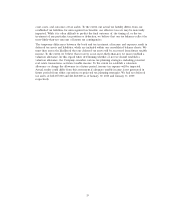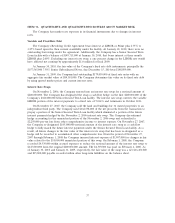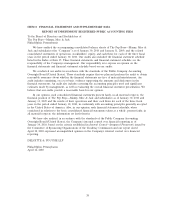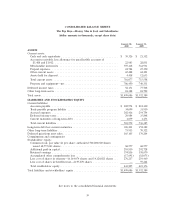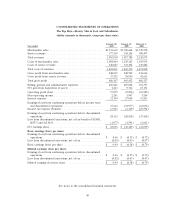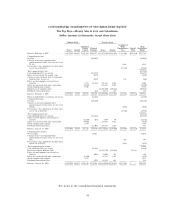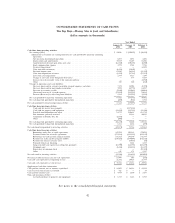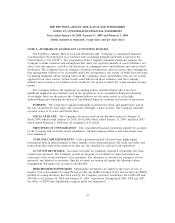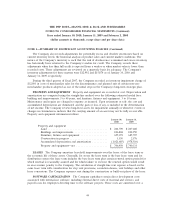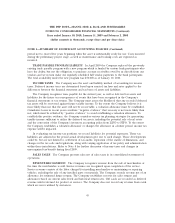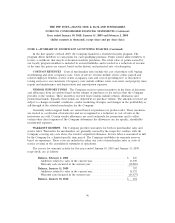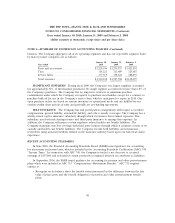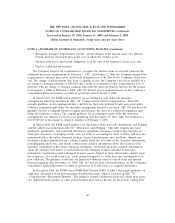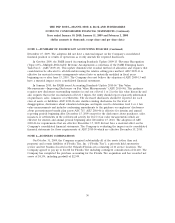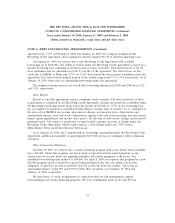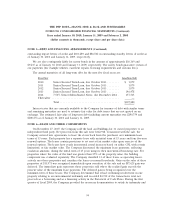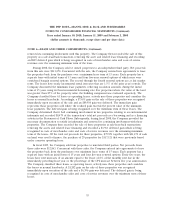Pep Boys 2009 Annual Report Download - page 103
Download and view the complete annual report
Please find page 103 of the 2009 Pep Boys annual report below. You can navigate through the pages in the report by either clicking on the pages listed below, or by using the keyword search tool below to find specific information within the annual report.THE PEP BOYS—MANNY, MOE & JACK AND SUBSIDIARIES
NOTES TO CONSOLIDATED FINANCIAL STATEMENTS (Continued)
Years ended January 30, 2010, January 31, 2009 and February 2, 2008
(dollar amounts in thousands, except share and per share data)
NOTE 1—SUMMARY OF SIGNIFICANT ACCOUNTING POLICIES (Continued)
period not to exceed five years beginning when the asset is substantially ready for use. Costs incurred
during the preliminary project stage, as well as maintenance and training costs are expensed as
incurred.
TRADE PAYABLE PROGRAM LIABILITY In April 2009 the Company replaced the previously
existing trade payable program with a new program which is funded by various bank participants who
have the ability, but not the obligation, to purchase account receivables owed by us directly from our
vendors and we in turn make our regularly scheduled full vendor payments to the bank participants.
The total availability under the new program was $50,000 as of January 30, 2010.
INCOME TAXES The Company uses the asset and liability method of accounting for income
taxes. Deferred income taxes are determined based upon enacted tax laws and rates applied to the
differences between the financial statement and tax bases of assets and liabilities.
The Company recognizes taxes payable for the current year, as well as deferred tax assets and
liabilities for the future tax consequences of events that have been recognized in the Company’s
financial statements or tax returns. The Company must assess the likelihood that any recorded deferred
tax assets will be recovered against future taxable income. To the extent the Company believes it is
more likely than not that the asset will not be recoverable, a valuation allowance must be established.
Cumulative losses in recent years constitute ‘‘negative evidence’’ that recovery is not more likely than
not, which must be rebutted by ‘‘positive evidence’’ to avoid establishing a valuation allowance. To
establish this positive evidence, the Company considers various tax planning strategies for generating
taxable income sufficient to utilize the deferred tax assets, including the potential sale of real estate
and the conversion of the Company’s inventory accounting policy from LIFO to FIFO. To the extent
the Company establishes a valuation allowance or changes the allowance in a future period, income tax
expense will be impacted.
In evaluating our income tax positions, we record liabilities for potential exposures. These tax
liabilities are adjusted in the period actual developments give rise to such change. Those developments
could be, but are not limited to, settlement of tax audits, expiration of the statute of limitations, and
changes in the tax code and regulations, along with varying application of tax policy and administration
within those jurisdictions. Refer to Note 8 for further discussion of income taxes and changes in
unrecognized tax benefit during fiscal 2009.
SALES TAXES The Company presents sales net of sales taxes in its consolidated statements of
operations.
REVENUE RECOGNITION The Company recognizes revenue from the sale of merchandise at
the time the merchandise is sold. Service revenues are recognized upon completion of the service.
Service revenue consists of the labor charged for installing merchandise or maintaining or repairing
vehicles, excluding the sale of any installed parts or materials. The Company records revenue net of an
allowance for estimated future returns. The Company establishes reserves for sales returns and
allowances based on current sales levels and historical return rates. Gift cards are recorded as deferred
revenue until redeemed for product or services. The Company does not record any revenue from cards
which are never utilized by customers.
45


